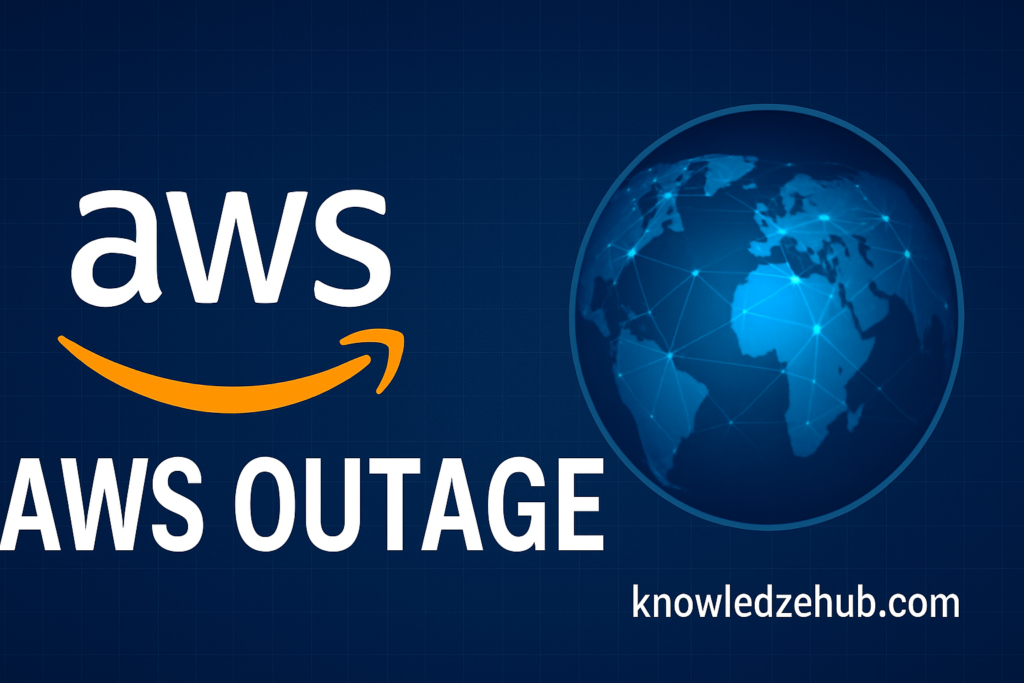On 20 October 2025, the cloud-computing world wobbled. Services that underpin our digital lives—from streaming platforms to banking apps—flickered, stalled or vanished. At the heart of that disruption was AWS: Amazon Web Services (AWS), the cloud-giant whose infrastructure supports vast swathes of the internet.
In this piece, we unpack what happened, why it matters, how AWS responded, what the broader implications are for enterprise, governance and resilience — and what lessons we must take away in a world increasingly on the cloud.
- What Happened? The AWS Outage – Timeline & Scope
- The Technical Root Cause of AWS Outage: What Went Wrong?
- Business & User Impact: How Deep Was the AWS Outage Disruption?
- Why It Matters: The Broader Significance
- AWS Response: What They Did, What They Communicated
- Lessons for Enterprises & Cloud Practitioners
- The Bigger Picture: Cloud-Reliance, Infrastructure Fragility & Regulation
- Post-Mortem and Looking Forward: What’s Next?
- Why Did This Keep Happening? AWS History of Outages
- Reflection: What This Means for India, Asia and Emerging Markets
- Concluding Thoughts
What Happened? The AWS Outage – Timeline & Scope
According to multiple sources, AWS experienced a major global outage on 20 October 2025 that impacted thousands of apps, websites and services worldwide.
Key facts and timeline
- The incident began in the early hours (US time) and followed by escalating error rates and latencies.
- AWS reported that the disruption was concentrated in its US-EAST-1 region (Northern Virginia), one of its oldest and largest clusters.
- On the AWS Service Health Dashboard, the company noted: “We can confirm increased error rates for requests made to the DynamoDB endpoint in the US-EAST-1 Region.”
- Later, AWS identified a “potential root cause”: “The problem appears to be related to DNS resolution of the DynamoDB API endpoint in US-EAST-1, … an underlying internal subsystem responsible for monitoring the health of our network load balancers.”
- The company said services had “returned to normal operations” by late afternoon (US Eastern Time).
Scope of the disruption
- Affected platforms included major social media apps, gaming services, streaming platforms, financial and banking services, consumer apps and more.
- Reports via Downdetector and other monitoring services suggested millions of individual user incidents globally.
- The ripple effect extended across regions and industries, illustrating how a single cloud provider outage propagates far and wide.
Why the region & substrate matter
US-EAST-1 is a major default region for AWS services. Many global services use it either by default or as a hub. Its prominence means issues there carry outsized risk.
The Technical Root Cause of AWS Outage: What Went Wrong?
Understanding the technical fault is crucial—not because we can fix AWS ourselves, but because it reveals systemic risks.
Subsystem monitoring network load-balancers
AWS stated that the underlying internal subsystem — responsible for monitoring the health of its network load-balancers (which distribute traffic across servers) — malfunctioned. When this health-monitoring system misbehaves, the load-balancers may misroute or drop traffic, leading to elevated error rates.
DNS resolution of an API endpoint
A significant clue: the issue appears tied to DNS resolution for the DynamoDB API endpoint in US-EAST-1. If a service cannot correctly resolve the name of the endpoint, clients can’t reach the service, even if the infrastructure is up. AWS cited this specifically.
Cascade effect due to dependencies
Because many services rely on that region and on DynamoDB (and global tables tied to it), failures there trigger secondary failures. For example, global services or features that rely on US-EAST-1 endpoints (such as IAM updates, DynamoDB global tables) also experienced trouble.
Throttling and backlog
AWS temporarily restricted new activity in certain impaired operations (for example launches of new EC2 instances) in order to stabilise traffic. Even after main services resumed, residual backlogs in processing remained.
Not a malicious attack
AWS and analysts emphasised the outage was not caused by a cyber-attack (as of current public statements). Rather, it appears to have been an internal systems failure with cascading consequences.
Business & User Impact: How Deep Was the AWS Outage Disruption?
When a cloud-provider like AWS goes down, many services downstream suffer. Here’s a breakdown of the impacts.
Consumer apps & social media
Platforms such as Snapchat, Fortnite (and associated services), Discord (or at least reporting of issues), and others suffered login issues, latency and outages.
Streaming & gaming
Streaming apps, gaming platforms and associated backend services (leaderboards, online sessions) saw disruptions—users could not connect or maintain sessions.
Financial services, banking & commerce
Banks and payment apps relying on AWS infrastructure were impacted. For example, in the UK, banks like Lloyds Bank, Bank of Scotland reported issues. The UK’s tax and customs website HM Revenue & Customs (HMRC) also faced trouble.
Airlines/travel
There were reports of airline booking/check-in/seat assignment systems being slow or unavailable, owing to the underpinning cloud infrastructure.
Enterprise services & SaaS
Businesses relying on AWS for SaaS, internal tools or external-facing services faced downtime or latency. Even tools used for corporate communication, monitoring or operations were affected.
Residual backlog and delayed processing
Even after major services were reported as restored, some AWS services (e.g., AWS Config, Redshift, Connect) continued to face a backlog of work to process. AWS noted this would take additional hours.
Costs & productivity loss
For many companies each hour of cloud-downtime translates into lost revenue, lost productivity, customer dissatisfaction and reputational cost. Analysts emphasised this.
Global user count
Millions of user-reports flooded monitoring services like Downdetector: for example, 8.1 million reports accounted in one region context according to The Guardian.
Why It Matters: The Broader Significance
This outage isn’t just an isolated tech glitch. It illuminates some of the structural features and risks of our digital-age infrastructure.
Cascading dependencies
When an internal subsystem (e.g., monitoring or DNS) fails, the effect cascades beyond discrete components to entire user-facing ecosystems. What may seem like an “internal” glitch becomes an “external” outage.
Resilience & trust in cloud vendors
Enterprises increasingly rely on cloud platforms for mission-critical systems. Such outages raise questions: What are the SLAs? How do we design for resilience if underlying infrastructure fails? This incident may reshape how companies plan architecture (multi-region, multi-provider, hybrid).
Regulatory and governance implications
Given the scale of impact, governments and regulators may view such infrastructure as “critical national infrastructure”. The UK government, for example, was reportedly in contact with AWS regarding the event.
Visibility into backbone of the internet
End-users rarely see the “plumbing” of the internet; cloud services are assumed to “just work”. Incidents like this shine a spotlight on how much of our daily life depends on a few large providers and how brittle that can be.
Economic consequences
Beyond user frustration, downtime can mean large economic losses—for users, for businesses and potentially for broader economies (especially if financial systems, payments or essential services are tied in).
AWS Response: What They Did, What They Communicated
How AWS navigated this outage offers insight into best practices and communication strategy.
Initial acknowledgement & updates
- AWS quickly noted “increased error rates and latencies for multiple AWS Services in the US-EAST-1 Region”.
- Showed transparency in identifying DynamoDB API endpoint and DNS resolution as potential root causes.
Mitigation steps
- AWS applied initial mitigations, including throttling new requests/operations in impaired services to limit further degradation.
- Worked on multiple parallel paths to recover services.
Service restoration
- AWS declared that by late afternoon ET, services had returned to normal operations.
- Noted that even though the system was operational, some components still had backlog processing or residual latency, acknowledging that full recovery takes additional time.
Post-incident investigation
- AWS committed to ongoing investigation; the statement referenced “potential root cause” – indicating continued work.
- Transparency in attributing the cause to internal subsystem rather than immediately pointing to attack is a positive sign for clarity.
Communication challenges
- Some critics will note that AWS could have provided more detailed public updates or more granular visibility (e.g., region-specific statuses).
- For downstream customers, reliance on a provider’s status page for real-time info is often unsatisfactory — especially when large customer impact is already occurring.
Lessons for Enterprises & Cloud Practitioners
What must businesses, architects and IT leaders take away? Multiple themes emerge.
Architect for failure
- Build with the assumption that cloud providers will fail. Use multi-region deployments (not single region), multi-availability-zone, and ideally multi-cloud when feasible.
- Design for graceful degradation: downstream systems should tolerate upstream partial failures without catastrophic outage.
Avoid single-region reliance for critical endpoints
- If services default to a specific region (e.g., US-EAST-1), check for region-agnostic architectures or fallback options.
- Compute, data, backups and endpoints being tied to one region magnifies risk.
Dependence on managed services needs scrutiny
- Using managed services (DynamoDB, SQS, etc) is efficient—but when those managed services fail, you are deeply dependent. Consider alternative patterns or fallback.
- Understand the service dependencies: e.g., if your global tables rely on US-EAST-1 endpoint, realize the availability risk.
Retry and idempotency strategies
- AWS recommended customers “continue to retry failed requests” during their recovery. The Economic Times Implementing exponential back-off, idempotent operations and retry logic is essential.
- Avoid cascading failures inside your own architecture due to massive retries.
Monitoring and multi-provider observability
- Use independent monitoring (outside your cloud provider) to detect issues early.
- Track not just your app, but underlying infrastructure health, API error rates, latencies and endpoint resolution issues.
Communication and incident response
- Have a plan for communicating outages to stakeholders and customers—both upstream (cloud provider) and downstream (users).
- During a large outage, transparency and timely updates matter for trust.
Insurance, risk modelling and business continuity
- Businesses must model the financial and reputational risk of cloud-provider outage. This includes lost revenue, customer experience hits, brand damage and regulatory risk.
- Consider SLA credits, contractual protections and designs for alternative paths.
Governance and oversight
- Large organisations (and critical infrastructure providers) may need oversight similar to utilities. Regulators may require reporting of “major cloud failures”.
- Risk committees should include vendor risk, supply-chain risk and cloud-dependency risk.
The Bigger Picture: Cloud-Reliance, Infrastructure Fragility & Regulation
This incident is a flash-point for some broader structural themes in the digital era.
Cloud platforms as critical infrastructure
As the Cloud becomes the dominant delivery model for software, services and even national-level systems, cloud-providers increasingly occupy the role of critical infrastructure. This incident may accelerate discussions around classification, regulation and resilience obligations.
Concentration of providers = systemic risk
The fact that outages in one provider (AWS) can knock out thousands of downstream services globally shows the systemic risk of reliance on a small set of hyper-scale clouds. Diversification of infrastructure may become not just a best-practice but a regulatory expectation.
Geographic concentration risks
Even within one provider, concentrating resources (data-centres, region defaults) in one location (e.g., US-EAST-1) increases risk of correlated failures. The geography of cloud infrastructure matters for resilience.
Transparency & public-interest
When services that support banking, healthcare, government, education and citizen-services go offline because of a cloud outage, there is a public interest dimension. Governments may demand more transparency from cloud-providers about architecture, failure modes and resilience.
Cyber-resilience vs. operational resilience
Often attention goes to cybersecurity (attacks, breaches) — but incidents like this remind us that operational resilience (bugs, subsystems failing, DNS issues) is equally important, and sometimes forgotten.
Lessons for developing countries & emerging markets
Cloud-adoption is strong in India, Southeast Asia and other emerging markets. These regions must ensure that cloud-dependency does not become a fragility. Enterprises and governments must consider local-region secondary/back-up strategies, hybrid clouds, and multi-cloud architectures.
Post-Mortem and Looking Forward: What’s Next?
What AWS may do
- Conduct a full forensic investigation into the subsystem failure and publish (at least internally) deep-dive learnings.
- Review and strengthen its region-failover capabilities, especially given repeated incidents in US-EAST-1.
- Consider offering more transparent status-dashboards, improved downstream communication and richer incident-reporting.
- Encourage users to adopt multi-region/multi-AZ/multi-cloud architectures by offering guidance, tooling and possibly incentives.
What enterprises should do now
- Review their current AWS (or cloud) architecture: Are they over-dependent on one region?
- Conduct “what-if” failure scenarios (e.g., region offline, managed service unavailable, API endpoint unreachable).
- If mission-critical systems live in one region, consider disaster-recovery (DR) strategies across regions/providers.
- Revisit SLAs and vendor-contracts: what compensation/credits apply, what communication obligations exist?
- Strengthen internal operations: monitoring, incident-response plans, customer-communication templates.
Wider ecosystem implications
- Cloud-provider competition might increase: enterprises may more strongly evaluate alternatives (Microsoft Azure, Google Cloud Platform, regional clouds) and adopt hybrid strategies.
- Regulators may start asking for “cloud resilience” reporting from critical services (banks, telecoms, public sector) and cloud-vendors.
- Insurance industry may adjust for “cloud-downtime” risk explicitly; premiums for digital-service providers may factor cloud-provider outage exposure more heavily.
- Service-design philosophies may evolve: even if the cloud provider is massively reliable, downstream services must build for upstream failure.
Why Did This Keep Happening? AWS History of Outages
This wasn’t AWS’s first large outage. Its history provides context.
- AWS’s US-EAST-1 region has experienced notable outages before (2020, 2021, other smaller incidents).
- Wikipedia notes significant service outages in AWS’s past.
- The repeated incidents in the same region suggest that even hyper-scale providers face residual risk in parts of their infrastructure.
Understanding this helps organisations treat “cloud provider failure” not as theoretical but as something to plan for.
Reflection: What This Means for India, Asia and Emerging Markets
Given you are in Bengaluru and operating within the Indian / Asia-Pacific context, there are particular considerations.
Regional growth of cloud adoption
India and Asia-Pacific have seen rapid cloud uptake—for startups, enterprises and government. Many services rely on global cloud providers like AWS, Azure, GCP. The outage underscores the need for region-specific resilience.
Local region footprints
AWS already has an Asia-Pacific (Mumbai) region. But relying solely on that, or a single provider, still carries risk. Organisations in India should consider multi-region (Mumbai + Hyderabad + Singapore) or multi-cloud (AWS + Azure + GCP) strategies.
Data sovereignty, regulation & governance
As Indian regulators develop frameworks around data localisation, critical infrastructure, cloud-resilience and vendor lock-in, events like this global outage will fuel the policy debate. Governments may mandate requirements for cloud-providers and for organisations using them.
Digital economy implications
India’s digital payments ecosystem (Unified Payments Interface, fintech apps), streaming platforms, SaaS companies, government digital services all depend on robust cloud infrastructure. A cloud outage of this magnitude can disrupt large swathes of digital-economy activity.
Opportunity for local cloud/edge-cloud players
This kind of event may open opportunities for local cloud/edge-cloud providers or alternative architecture models (e.g., distributed edge, hybrid) to reduce dependence on globally-centralised infrastructure.
Concluding Thoughts
The 20 October 2025 AWS outage is, at one level, just another outage in the cloud-computing era. But at another level, it is a sharp reminder of the fragility that lies beneath the modern digital economy’s façade of “always on”.
When a subsystem meant to monitor load-balancers fails, or DNS resolution goes awry, the impact is not just technical — it is organisational, economic and societal.
Cloud-providers bring enormous benefits: scalability, global reach, cost-efficiency, ease of management. But the story now is about resilience, diversity, contingency and architecture. Organisations can no longer treat cloud infrastructure as infinitely reliable. They must design for failure, risk-engineer their dependencies and communicate clearly with their stakeholders.
Likewise, cloud providers must continue to raise their game—not just in uptime statistics, but in transparency, resilience planning, customer communication and ecosystem support. Regulators may need to step in to ensure that the backbone of the internet (and of our economies) is held to standards befitting its role.
For us as users, we rarely notice the plumbing of the internet. But when it fails, the effect is unmistakable: apps that don’t load, banking transactions that stall, video calls that drop, home-automation devices that go dark. And when it happens globally, what we witness is not just a service outage—it’s a moment of collective digital fragility.
In short: the cloud may feel invisible, but its failure is visible — loud, impactful and far-reaching. The challenge ahead is not just to build bigger clouds but to build smarter, more resilient ones. Organisations big and small should treat this outage not just as a cautionary tale, but as a call to action.



